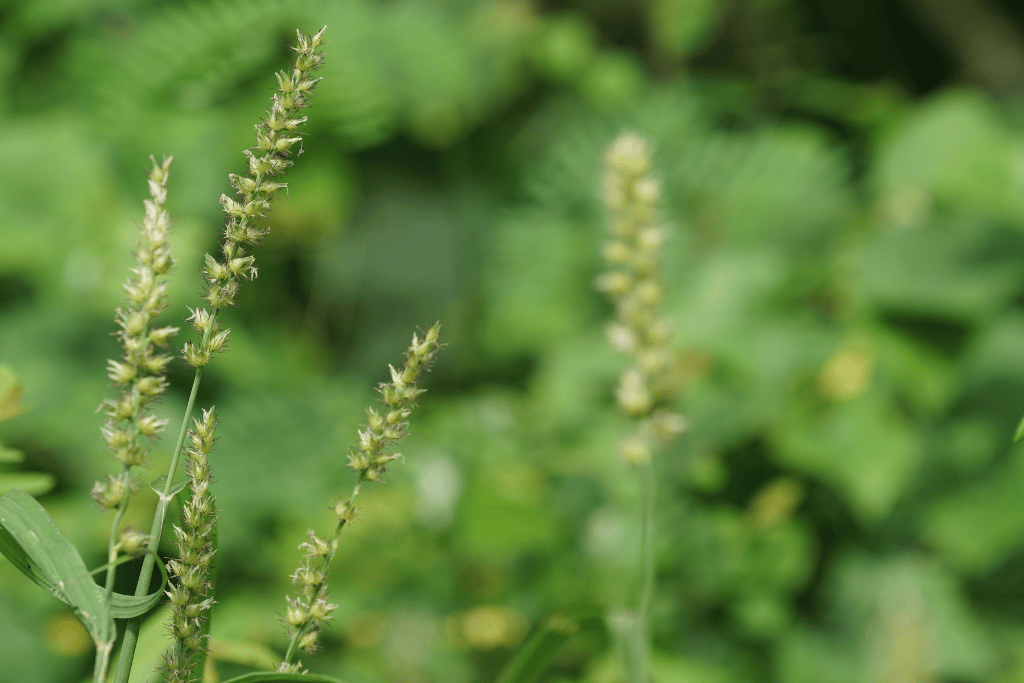There are so many amazing things that start with the letter “P” – picturesque landscapes, playful puppies, and palatable treats. But today, I want to talk about flowers that start with P, where petals and colors intertwine to create nature’s masterpieces.
These botanical wonders possess a charm that’s impossible to ignore, each bloom has the tendency to change the aura of your garden.
I’m talking about the delicate and ethereal peonies, the vibrant and cheerful pansies, and so many other P-flowers too.
In this journey through the alphabet’s floral world, we’ll encounter the proud snapdragons, standing tall with their snout-like blossoms. I’ll help you explore the enchanting world of flowers that start with the letter P.
So, let’s begin.
30 Flowers That Start With P
1. Peony – Majestic Blooms of Elegance

Peonies, perennial beauties belonging to the Paeoniaceae family, grace gardens and landscapes with their sumptuous petals, showcasing shades of pink, white, red, and even yellow. With their intricate layers of velvety petals, peonies exude an air of timeless elegance, drawing admirers into their enchanting allure. In various cultures, they symbolize prosperity, honor, and romance. The Peony Festival in Luoyang, China, stands as a testament to their importance, drawing visitors from around the world to witness the breathtaking spectacle of blooming peonies.
These magnificent flowers thrive in temperate climates, their lush foliage complementing their stunning blooms. Each type offers a unique visual treat, from herbaceous varieties to tree peonies. While their attractive appearance makes them a favorite in floral arrangements and wedding bouquets.
2. Primrose – Delicate Heralds of Spring

With the arrival of spring, Primroses usher in a symphony of color, adorning gardens and woodland edges with their delicate blooms. These perennial plants, belonging to the Primulaceae family, thrive in cool climates and display an array of soft pastel hues, including shades of pink, purple, yellow, and white. A testament to their versatility, primroses can be found in flower beds, rock gardens, and containers. Their early bloom time offers a much-needed burst of color after winter’s dormancy. Their dainty flowers often have a distinct yellow or contrasting center, adding to their visual charm.
Primroses hold a special place in folklore and literature, often associated with youthful innocence and the enchantment of spring. In Victorian flower language, they symbolize young love and devotion. These versatile plants come in various species, each with its own unique growth habits and preferences. Some prefer shade, while others thrive in partial sunlight, making them adaptable to different garden environments.
3. Pansy – Vibrant Expressions of Joy

Pansies, with their vibrant and distinct “faces,” paint landscapes with a palette of cheerful colors. In the language of flowers, they symbolize thoughtfulness and remembrance, making them popular choices for gifts and floral arrangements. Their early bloom time, often during the colder months, adds a welcome burst of color to gardens. Available in a wide range of hues, including blues, purples, yellows, and oranges, pansies bring an element of playfulness to gardens, borders, and containers.
Beyond their ornamental value, pansies hold cultural significance in different regions. Pansies are versatile and adaptable, thriving in both sun and partial shade. Their low-maintenance nature makes them ideal for beginner gardeners or anyone seeking to add a splash of color to their outdoor spaces. Whether planted in beds or hanging baskets, pansies’ vibrant expressions of joy continue to brighten the hearts of those who encounter them.
4. Petunia – Cascades of Colorful Abundance

Petunias, trumpet-shaped blooms create a stunning visual impact whether planted in hanging baskets, containers, or flower beds. Their cascading blossoms and vibrant hues transform gardens into a haven of color and beauty. These annual flowering plants, members of the Solanaceae family, offer an extensive range of colors, from bold purples and pinks to soft pastels and even striking blues. With their abundance of colors and ease of cultivation, petunias offer a delightful canvas for both seasoned gardeners and newcomers, enhancing outdoor spaces with their cascades of colorful exuberance.
In the language of flowers, petunias symbolize various sentiments, from youth and playfulness to admiration and soothing emotions. Petunias have earned their place as popular garden choices due to their profuse flowering and adaptability. They flourish in full sun and well-draining soil, creating lush blankets of color throughout the warm months. Their delightful fragrance and long-lasting blooms make them a favorite for attracting pollinators like bees and butterflies.
5. Phlox – Carpet of Fragrant Beauty

With their striking appearance and captivating scent, phlox often takes center stage in cottage gardens and naturalistic landscapes. Symbolizing harmony and unity, phlox holds a special place in the language of flowers. It’s a versatile plant, thriving in a variety of soil conditions and light levels. Whether you’re looking to add vertical interest or create a fragrant groundcover, phlox offers a delightful solution, painting gardens with its beauty and infusing the air with its sweet aroma.
Phlox, often referred to as “Summer’s Delight,” graces gardens with its lush carpets of fragrant blossoms. These perennial plants, belonging to the Polemoniaceae family, come in two main varieties: tall garden phlox and creeping phlox. Tall garden phlox showcase their vibrant flower clusters on tall stems, offering a vertical burst of color in borders and beds. Creeping phlox, on the other hand, spread low to the ground, creating a stunning groundcover. Phlox blooms in a spectrum of colors, including white, pink, purple, and blue, filling the air with a pleasant fragrance that attracts pollinators like bees and butterflies.
6. Protea – Majestic Marvels of Diversity

Proteas hold cultural significance as national emblems and symbols of endurance, change, and diversity. They are often used in floral arrangements and bouquets, bringing a touch of wild beauty to indoor spaces. Their resilience and remarkable aesthetics ensure that proteas remain cherished marvels that inspire awe and admiration. Proteas, often hailed as nature’s artwork, are a diverse group of flowering plants that command attention with their intricate and exotic beauty.
Native to regions such as South Africa and Australia, proteas thrive in diverse environments, from mountain slopes to coastal landscapes. Their unique structure, resembling a mix of petals and bracts, adds to their allure. These flowers often attract pollinators like birds, showcasing their role in local ecosystems. Belonging to the Proteaceae family, these stunning blooms exhibit a wide range of shapes, sizes, and colors, making them a true testament to nature’s creative prowess. From vibrant pinks and oranges to more subtle creams and greens, proteas offer a captivating spectrum of hues.
7. Papaver – Whispers of Delicate Splendor
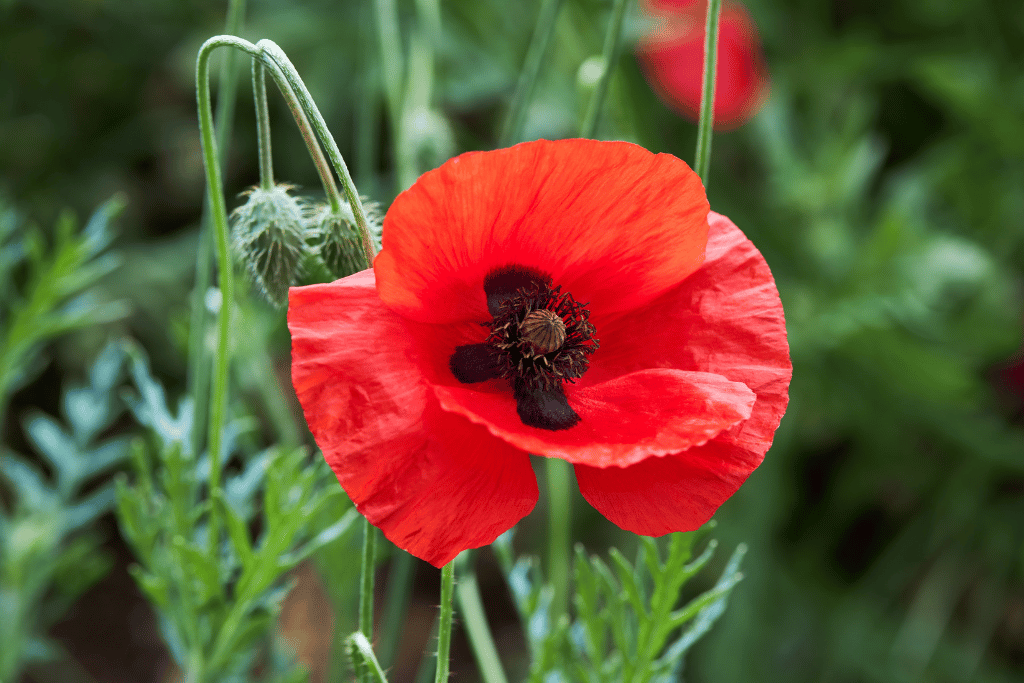
Papaver, commonly known as poppies, grace gardens and meadows with their delicate petals and symbolic significance. Poppies have long held cultural and historical importance, representing diverse meanings across different cultures. They symbolize remembrance and honor for fallen soldiers in various countries. Furthermore, opium poppies have been cultivated for their medicinal properties for centuries.
These flowering plants, part of the Papaveraceae family, feature papery blooms in shades of red, orange, pink, and white. With their ethereal appearance and fluttering petals, poppies evoke a sense of ephemeral beauty that captivates all who behold them. Poppies are versatile plants, thriving in a variety of soil conditions and climate zones. Whether adorning landscapes, borders, or wildflower gardens, they add a touch of subtle splendor to outdoor spaces. Poppies also produce interesting seed pods that contribute to their visual appeal even after the flowers have faded.
8. Portulaca – Radiant Resilience in Arid Beauty
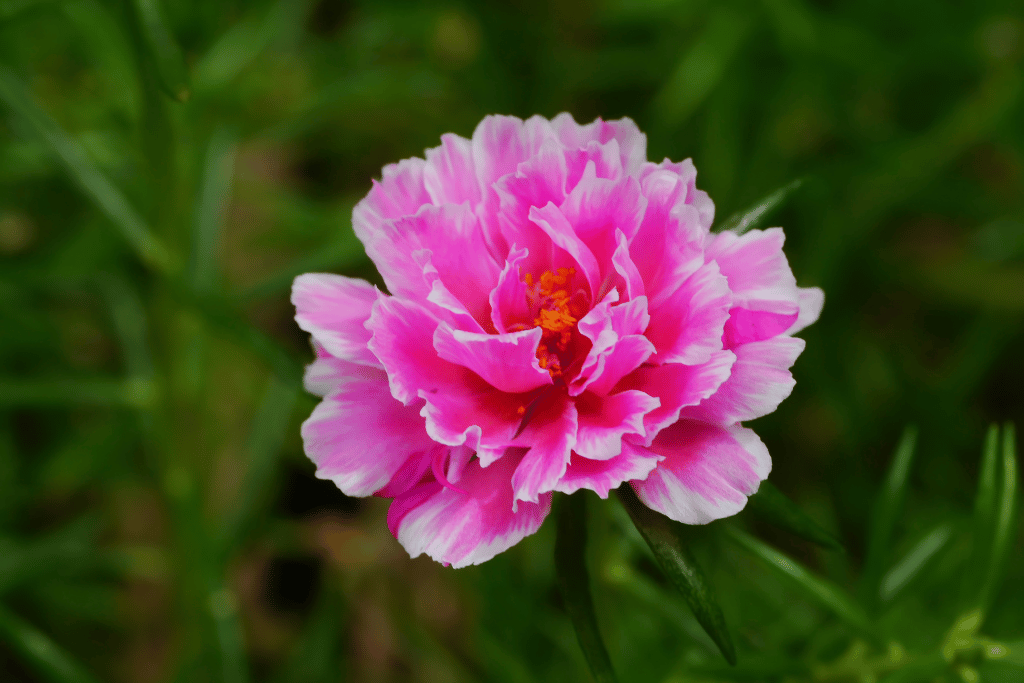
Symbolizing both endurance and gratitude, portulacas are a charming addition to rock gardens, containers, and hanging baskets. Belonging to the Portulacaceae family, these low-growing plants feature vibrant, jewel-toned flowers in shades of red, pink, orange, yellow, and white. Their ability to bring vibrant hues to spaces with minimal water availability makes them a valuable asset for sustainable gardening practices. Portulaca’s radiant beauty and unwavering tenacity serve as a reminder of nature’s ability to flourish even in the harshest of conditions.
Portulaca, often called moss rose or purslane is a resilient succulent flourishing in hot and dry conditions. Their delicate, silk-like petals create a striking contrast against their succulent foliage, making them a favorite for adding color to arid landscapes and sunny spots. Portulaca’s ability to thrive in harsh environments showcases its adaptability and resilience. Its succulent nature allows it to store water, making it a perfect choice for xeriscaping and water-wise gardening. The flowers are open during the day and close at night, adding an element of surprise to their beauty.
9. Penstemon – Nature’s Symphony of Grace

Penstemons’ slender, elegant blooms make them a sought-after addition to cottage gardens, borders, and native plant landscapes. As members of the Plantaginaceae family, these perennial plants come in an array of colors, ranging from soft pastels to bold purples, pinks, and reds. Their unique shape and vibrant hues attract hummingbirds, bees, and other pollinators, contributing to the ecological balance of their surroundings. They thrive in a variety of soil types and light conditions, showcasing their adaptability. These flowers have a longstanding presence in North American indigenous cultures, where they were used for their medicinal properties.
In the language of flowers, penstemons symbolize various sentiments, from admiration and gratitude to determination and resilience. With their delicate beauty and ecological importance, penstemons contribute to the overall harmony of natural and cultivated landscapes, standing as a living testament to nature’s symphony of grace. Penstemon, also known as beardtongue, enchants with its graceful spikes of tubular flowers that resemble open mouths.
10. Phalaenopsis – Elegance in Orchid Form

Phalaenopsis, often referred to as moth orchids, reign as the epitome of elegance among the orchid family. These tropical epiphytic plants display enchanting blooms that bear a resemblance to fluttering moths in flight. With their wide range of colors, including shades of white, pink, purple, and even bi-color variations, phalaenopsis orchids exude sophistication and allure.
Indigenous to Southeast Asia and Australia, phalaenopsis orchids have gained adoration for their beautiful shape and low-maintenance qualities. Their favor as indoor plants stems from their ability to adjust well to indoor environments. Flourishing under bright, indirect sunlight, phalaenopsis orchids are famous for their extended blooming periods. Symbolizing grace, beauty, and strength, phalaenopsis orchids are often chosen as gifts for various occasions. They are also frequently featured in elegant floral arrangements, adding a touch of sophistication to weddings, receptions, and special events. As living works of art, phalaenopsis orchids continue to inspire awe with their refined elegance and captivating presence.
11. Passion Flower – Intricate Beauty with Spiritual Symbolism

Native to tropical and subtropical regions, Passion Flowers display a wide range of colors, from shades of purple, pink, and blue to vibrant reds and oranges. Their ornate appearance and spiritual significance have made them a favorite subject in art and culture throughout history. Passion Flowers, belonging to the Passifloraceae family, are a group of mesmerizing vines that boast intricate and captivating blooms. These exotic flowers are known for their unique structure, featuring a central column of filaments surrounded by delicate, colorful petals. Their intricate design earned them their name, symbolizing the passion of Christ in Christian theology.
Whether adorning fences, trellises, or garden structures, Passion Flowers bring an element of mystery and enchantment to outdoor spaces. Their intricate beauty and profound symbolism continue to captivate the imagination and inspire awe. Beyond their aesthetic appeal, Passion Flowers play a vital role in supporting pollinators like bees and butterflies. Some species even produce edible fruits known as passion fruits or passion berries.
12. Pincushion Flower – Unique Blooms of Textured Charm
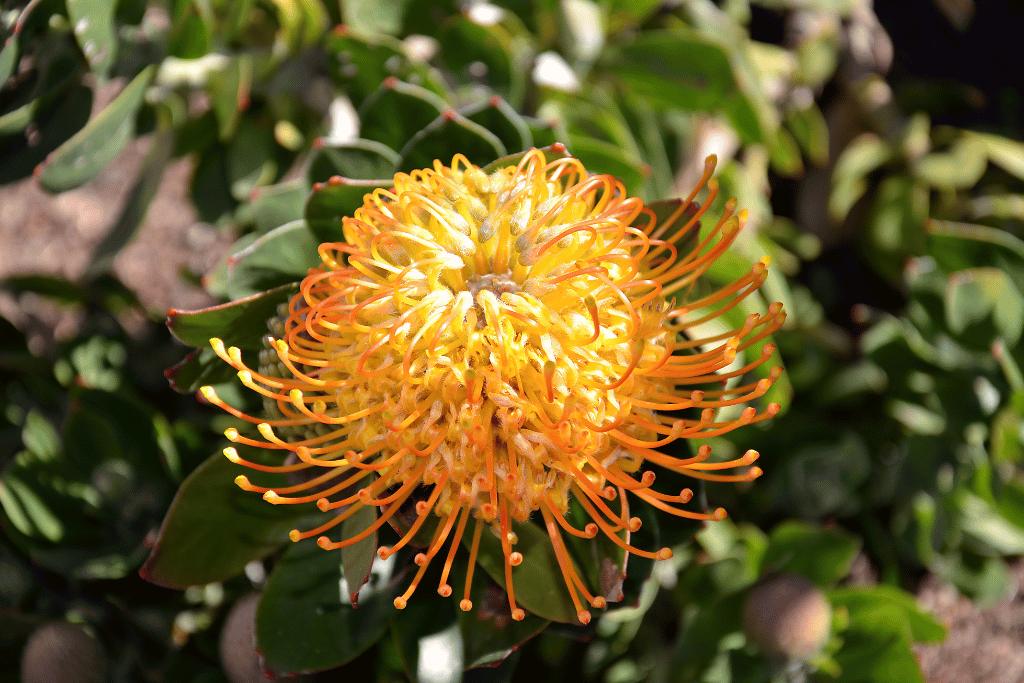
Pincushion Flowers, scientifically known as Scabiosa, present a delightful fusion of elegance and texture in their distinctive blooms. These perennial plants, members of the Caprifoliaceae family, display round bunches of small florets that give the impression of pincushions or pom-poms. The florets’ color ranges from soft pastels to bold purples and reds, attracting pollinators like butterflies and bees. Pincushion Flowers are cherished for their charming appearance and long-lasting blooms. Their distinct shape adds a hint of fanciful charm, making them particularly captivating in cottage-style gardens, meadows, and flower beds.
These flowers symbolize love, admiration, and sweet memories. They are also associated with healing properties in traditional herbal medicine. Their striking appearance and beneficial qualities have earned them a place of honor in both gardens and the language of flowers. Pincushion Flowers thrive in well-drained soil and sunlight, making them versatile and adaptable choices for various garden designs. With their textured charm and enduring beauty, they remind us of the intricate wonders nature has to offer.
13. Plumeria – Fragrant Beauties of Tropical Delight

Plumerias imbue their surroundings with a tropical charm and a fragrant grace, whether they grace gardens, patios, or indoor areas. Despite the fragile look of their blooms, these flowers possess a robust resilience, serving as a reminder that beauty and strength frequently walk together. These plants, also known as frangipani, transport us to tropical paradises with their intoxicating fragrance and stunning blossoms. These small trees or shrubs, belonging to the Apocynaceae family, boast waxy, five-petaled flowers that create a visual feast in shades of white, yellow, pink, and even multicolor varieties.
Native to regions such as Central America, the Caribbean, and the Pacific Islands, Plumerias are often associated with Hawaiian culture and leis. Their alluring scent, often used in perfumes and lotions, adds to their charm. Plumerias thrive in warm, sunny climates and well-drained soil. They hold a strong connection to spirituality in various cultures and symbolize beauty, charm, and grace.
14. Puya – Intriguing Architectural Marvels

Puyas’ blooms come in a variety of colors, including shades of blue, green, and red, often contrasted by sharp spines and bracts. These distinctive features contribute to their otherworldly appearance, resembling something from a fantasy landscape. Apart from their captivating aesthetics, Puyas play a vital role in local ecosystems, providing food and shelter to wildlife. They have adapted to survive in challenging environments, showcasing their resilience and adaptability.
As symbols of endurance and perseverance, Puyas make intriguing additions to succulent gardens, rockeries, and xeriscapes. Their unique form and remarkable blooms remind us of nature’s endless capacity for innovation and wonder. Puyas, members of the Bromeliaceae family, are intriguing and unique plants that command attention with their architectural beauty. These rosette-forming perennials originate from South America and thrive in mountainous regions. Their stunning flower spikes, which can reach impressive heights, are composed of intricate blooms that captivate with their intricate patterns.
15. Phormium – Graceful Drama in Foliage
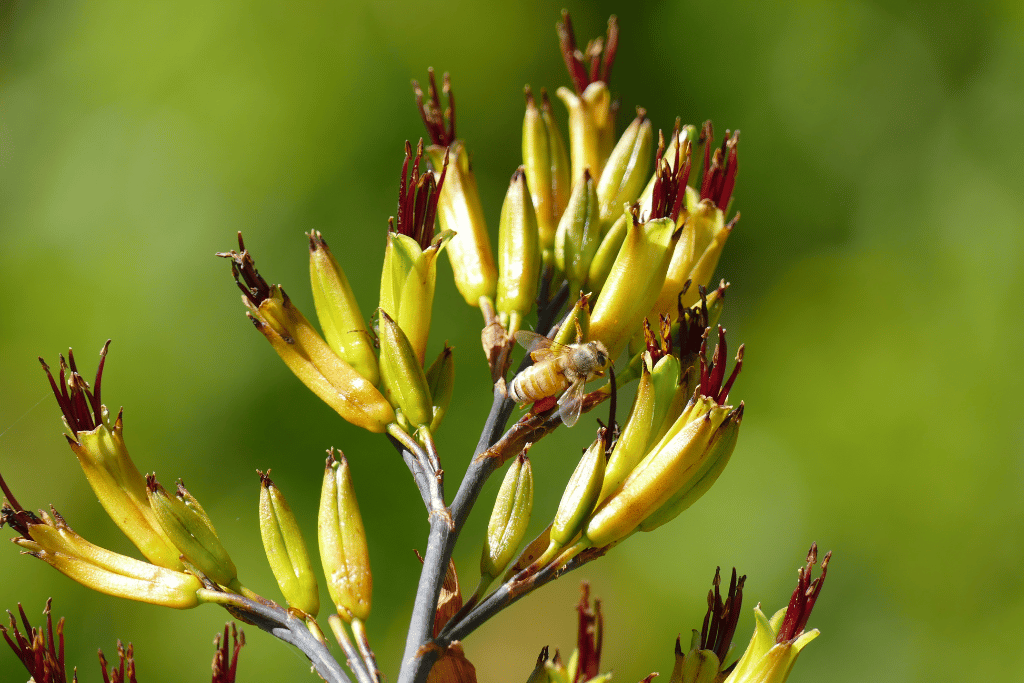
As symbols of endurance and strength, Phormiums remind us of the grace that can be found in foliage. With their dramatic form and vibrant colors, they continue to inspire gardeners to create dynamic and visually appealing outdoor environments. Phormium, recognized by the common name New Zealand flax, serves as evidence of how foliage can introduce both drama and grace to garden scenery. These perennial evergreens, members of the Phormiaceae family, display remarkable sword-shaped leaves available in a variety of hues, ranging from lush greens to lively reds and bronzes.
Originating from New Zealand, Phormiums thrive in a variety of climates and soil types, making them versatile choices for gardens and outdoor spaces. Their unique foliage provides a captivating contrast to other plants and adds texture and visual interest to landscapes. Phormiums require minimal maintenance and are often used as architectural accents in modern gardens. Their bold presence and architectural beauty make them ideal for creating focal points or adding structure to mixed plantings.
16. Pitcher Plant – Nature’s Carnivorous Marvel

Pitcher Plants, belonging to the Sarraceniaceae family, stand out as unique carnivorous plants that exhibit both beauty and intrigue. These remarkable plants, often found in boggy or wetland habitats, have specialized leaves that form intricate pitcher-like structures. These pitchers attract, trap, and digest insects and other small organisms, providing the plant with necessary nutrients in nutrient-poor environments. Beyond their carnivorous nature, Pitcher Plants also have cultural significance. In some Native American cultures, they are used in medicinal and ceremonial practices.
The diversity of Pitcher Plant species leads to a wide range of pitcher shapes, sizes, and colors. Some boast vibrant hues, while others exhibit delicate patterns, captivating the imagination with their curious adaptations. Whether grown as a curiosity or to aid in pest control, Pitcher Plants are a fascinating addition to gardens and collections. They serve as a reminder of nature’s intricate mechanisms for survival and adaptation, showcasing how plants can truly be marvels of biological engineering.
17. Peruvian Lily – Whimsical Blooms of Friendship
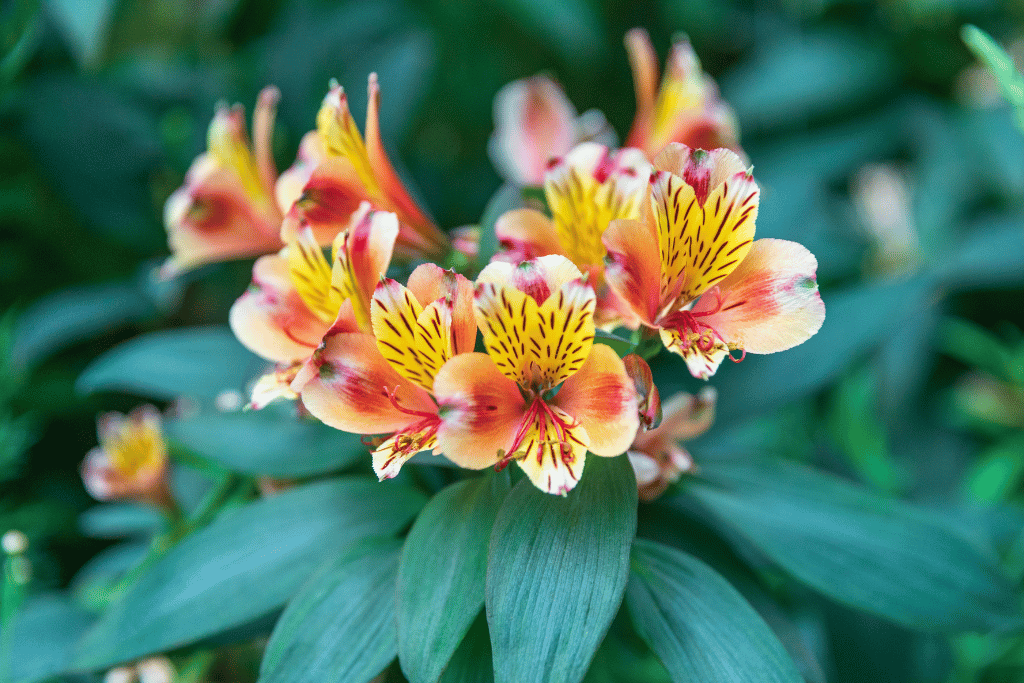
Peruvian Lilies hold special meaning in the language of flowers, symbolizing friendship and devotion. Their striking appearance and long vase life make them a popular choice for bouquets and floral designs. These lilies thrive in well-drained soil and sunny to partially shaded locations, making them adaptable to various garden settings. Their resilience and ability to produce abundant flowers ensure they remain cherished by gardeners and flower enthusiasts alike.
As symbols of lasting bonds and camaraderie, Peruvian Lilies continue to bring joy and warmth to both gardens and the hearts of those who receive them as tokens of affection. Peruvian Lilies, botanically known as Alstroemeria, grace gardens and floral arrangements with their whimsical and vibrant presence. These perennial plants, members of the Alstroemeriaceae family, are native to South America and boast clusters of delicate, trumpet-shaped flowers that come in a spectrum of colors, from soft pastels to bold oranges and reds.
18. Peniocereus – Night-Blooming Wonders

Peniocereus, a genus of cacti belonging to the Cactaceae family, boasts a unique and enchanting trait: their flowers bloom exclusively at night. Also known as night-blooming cereus or moonlight cacti, these plants reveal their stunning, fragrant flowers under the cover of darkness. Originating from the Americas, Peniocereus cacti come to life with their intricate, ephemeral blooms that emit a sweet fragrance to attract nighttime pollinators like moths and bats. These flowers often feature white petals and intricate, delicate structures.
The anticipation of witnessing Peniocereus flowers open at night adds a touch of mystery to gardening. Their fleeting nature emphasizes the transient beauty of nature’s creations. Growing Peniocereus can be a rewarding experience, as the sight of their rare and delicate blossoms emerging under the moon’s glow is nothing short of magical. As guardians of the night and symbols of hidden beauty, Peniocereus cacti remind us to appreciate the often-overlooked wonders of the natural world.
19. Paper Daisy – Whimsical Petals of Australia

Paper Daisies are a great choice for xeriscaping and water-efficient gardening, making a positive impact on eco-friendly landscaping methods. Flourishing in arid environments, they are commonly seen in sandy or rocky soils. With their distinctive petals and resilience in challenging environments, Paper Daisies offer a playful and spirited addition to gardens. Their ability to thrive in harsh conditions underscores their role as symbols of endurance and the beauty that can arise from adversity.
These flowers have cultural significance among Indigenous Australian communities, where they are used in traditional medicine and ceremonies. Paper Daisies, members of the Asteraceae botanical family, add a hint of enchantment and allure to dry terrains. These plants, whether perennial or annual, exhibit distinct papery petals in an array of colors including white, pink, yellow, and even two-tone blends. With their unique look, they bear a resemblance to delicate, stratified petals that ignite the imagination.
20. Painted Tongue – A Splash of Unique Color
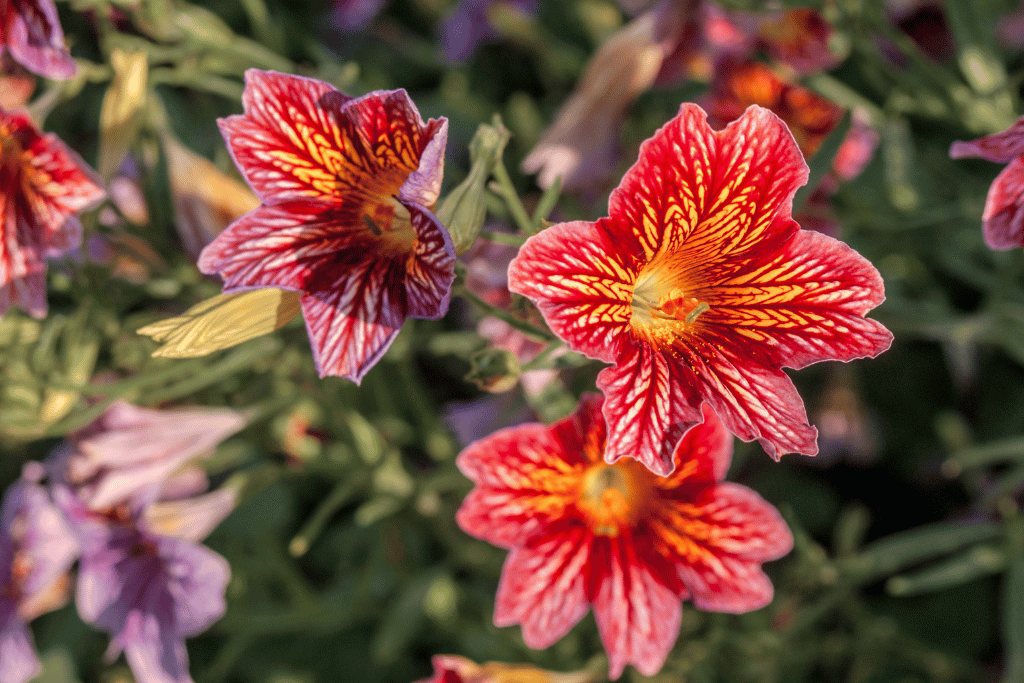
Originating from South America, Painted Tongues showcase a wide range of colors, from vibrant oranges and reds to soothing blues and purples. Their striking appearance and captivating patterns make them an ideal choice for infusing gardens with visual interest. As living canvases of color, Painted Tongues continue to enchant gardeners and admirers alike, reminding us of the boundless creativity that nature offers and the ability of flowers to evoke emotions through their exquisite forms.
Painted Tongue, botanically known as Salpiglossis, adds a splash of unique color and texture to gardens and floral arrangements. These annual or short-lived perennial plants, members of the Solanaceae family, exhibit trumpet-shaped blooms that feature intricate patterns and variegated hues. These patterns resemble brushstrokes of paint, giving the flower its artistic name. These flowers symbolize various sentiments, including gratitude and appreciation. They are often used in floral arrangements to add a touch of artistic flair.
21. Persian Buttercup – A Burst of Elegance

Persian Buttercups are adored for their densely packed petals that create a lush and opulent appearance. These flowers symbolize charm and attractiveness, making them a popular choice for bouquets and garden displays alike. With their graceful form and captivating hues, Persian Buttercups bring an air of elegance to gardens and arrangements, reminding us of the intricate beauty that nature can create.
Despite their delicate appearance, Persian Buttercups are hardy and can tolerate cooler temperatures, allowing them to brighten gardens in early spring or fall. They thrive in well-drained soil and ample sunlight. Persian Buttercups, known by their scientific name Ranunculus, burst onto the scene with their vibrant and layered petals. Originating from Asia and Europe, their bowl-shaped blossoms come in various colors, from rich reds and oranges to soft pastels and whites.
22. Princess Flower – Royalty in Rich Hues
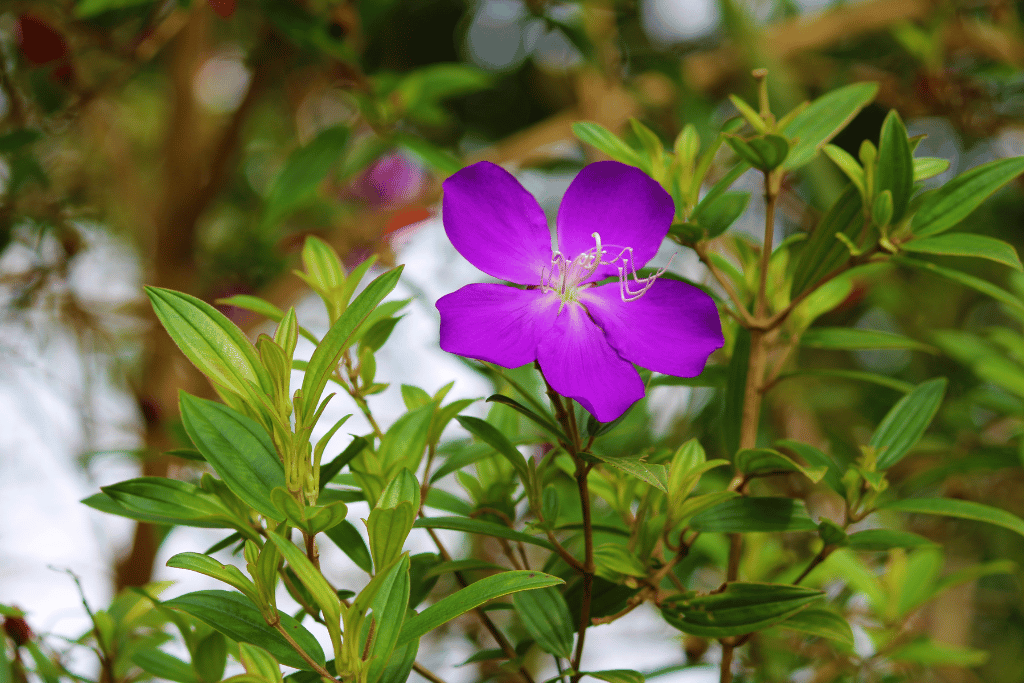
Princess Flowers showcase their regal presence both in their captivating blossoms and their velvety foliage. Their stunning appearance often attracts butterflies, enhancing the garden’s ecosystem. These shrubs thrive in warm climates and well-drained soil. Their prolific flowering and lush foliage make them popular choices for ornamental gardens and landscapes.
Princess Flower, also known by its scientific name Tibouchina, adds a touch of royalty to gardens with its lush blooms and rich hues. These flowering shrubs, members of the Melastomataceae family, hail from tropical regions in Central and South America. Their large, showy flowers boast vibrant shades of purple, violet, and pink. Symbolizing happiness and prosperity, Princess Flowers are fitting for gardens seeking to evoke a sense of elegance and luxury. Their velvety petals and bold colors remind us of the splendor that nature can bestow upon us.
23. Pineapple Lily – Whimsical Inflorescence

Originating from southern Africa, Pineapple Lilies showcase a range of colors, from pale greens to deep purples. Their charming appearance often draws the attention of pollinators like bees and butterflies. The botanical name of Pineapple Lily is Eucomis. It adds a touch of enchantment to gardens through its distinctive flower arrangement. These perennial plants, belonging to the Asparagaceae family, showcase flower spikes crowned with a cluster of leaves resembling the top of a pineapple.
Pineapple Lilies thrive in well-drained soil and sunny to partially shaded locations. They are well-suited for mixed borders, containers, and rock garden. With their playful form and intriguing texture, Pineapple Lilies bring a touch of the unexpected to outdoor spaces. Their ability to combine elegance and whimsy reminds us of nature’s endless capacity for creativity.
24. Plectranthus – Varied Foliage Delights
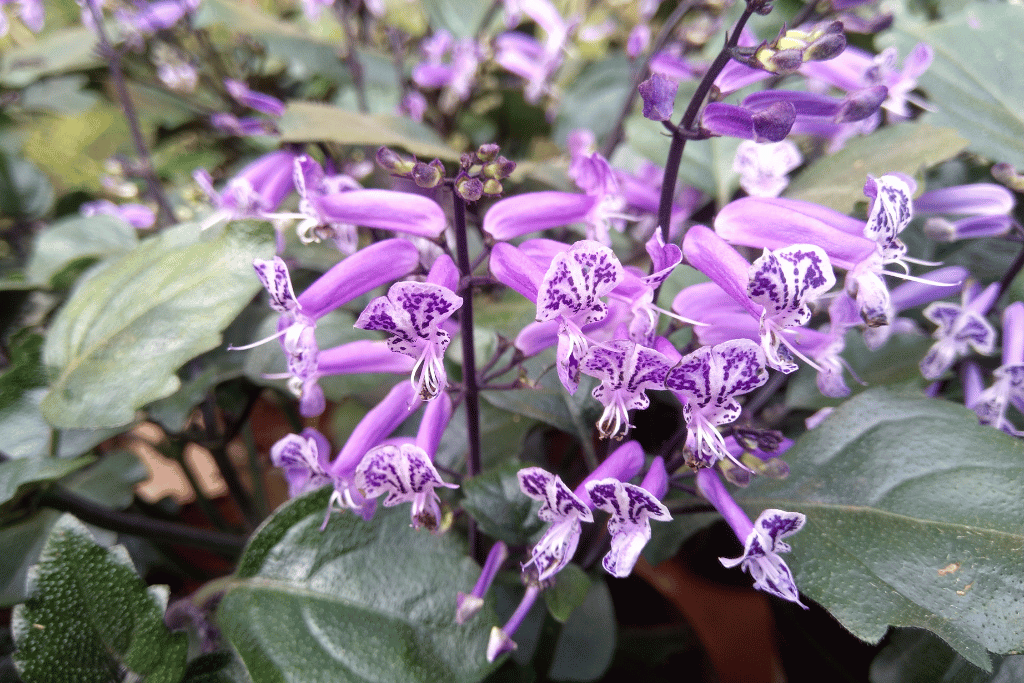
Plectranthus, often referred to as Swedish Ivy or Spur Flower, offers a diverse range of foliage delights to gardens. They are versatile and adaptable, thriving in various light conditions and soil types. They are commonly used in hanging baskets, containers, and as groundcovers. These flowering plants, members of the Lamiaceae family, encompass various species with different leaf shapes, sizes, and colors. Some varieties feature striking variegation, while others showcase rich shades of green.
Originating from Africa, Plectranthus thrives in warm climates and is often grown as an ornamental foliage plant. Some species produce small, tubular flowers that add an extra layer of visual interest. These plants symbolize abundance and growth, making them suitable for gardens seeking to embrace the lushness of nature. With their varied foliage and low-maintenance nature, Plectranthus offer a playful way to experiment with textures and colors in outdoor designs.
25. Persian Violet – Delicate Trailing Beauty

Known for its compact size and profuse flowering, Persian Violet is often used as a bedding plant or in hanging baskets. The flowers’ sweet fragrance adds an extra layer of appeal to this dainty beauty. These plants thrive in well-drained soil and partial to full sunlight. They are particularly well-suited for edging, borders, and creating low-maintenance displays of color.
Scientifically, Persian Violets are known as Exacum affine, graces gardens and containers with their delicate trailing growth habit and charming blossoms. This perennial plant, belonging to the Gentianaceae family, originates from the Mediterranean region and showcases clusters of star-shaped flowers in shades of purple, blue, and white. Persian Violets symbolize delicacy and charm and bring a touch of elegance to gardens and outdoor spaces. Their trailing habit and vibrant blossoms make them a favorite for adding visual interest to various garden designs.
26. Painted Lady – Nature’s Watercolor Masterpiece

Painted Lady thrives in sunny locations and well-drained soil. It is often used as a cut flower, as its bracts retain their color even after drying. Symbolizing artistic expression and beauty, Painted Lady adds a touch of whimsy and charm to gardens. Its ability to evoke the delicate hues of a watercolor painting makes it a standout choice for creating visually captivating outdoor displays.
Originating from Southern Europe and the Mediterranean, Painted Lady is beloved for its vibrant bracts that create the illusion of flowers in shades of pink, blue, and white. These bracts make the plant resemble an artist’s palette, inspiring its common name. Botanically identified as Salvia viridis, this plant introduces a vibrant splash of color that evokes the aesthetic of watercolor artworks into gardens and landscapes. Belonging to the Lamiaceae botanical family, this annual botanical specimen displays distinctive bracts that mirror the appearance of vividly hued petals encircling tiny and discreet flowers.
27. Prairie Gentian – Native Wildflower Beauty
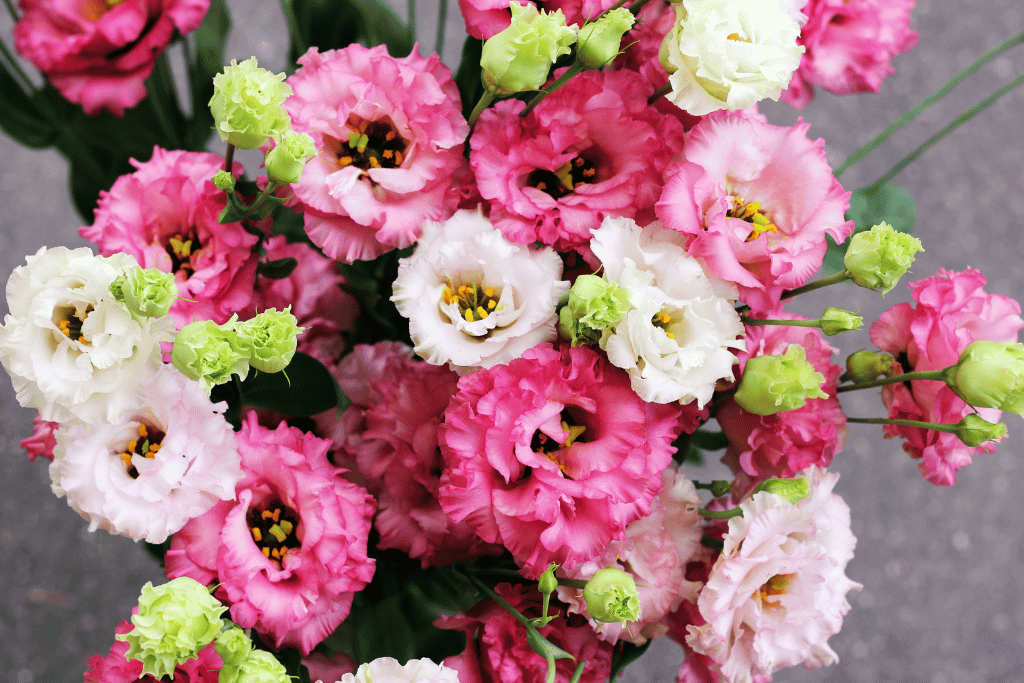
Prairie Gentian, scientifically known as Eustoma exaltatum, graces North American prairies with its delicate and captivating blossoms. This wildflower, part of the Gentianaceae family, showcases bell-shaped flowers in shades of blue, pink, and white. Prairie Gentian symbolizes gratitude and appreciation, making it a meaningful choice for naturalistic plantings and wildflower gardens. Its understated beauty and native origin add to its appeal as a sustainable and wildlife-friendly option.
Native to the central and eastern United States, Prairie Gentian thrives in grasslands and meadows. Its unique flowers and ability to attract pollinators like bees and butterflies contribute to its ecological importance. Thriving in full sunlight and well-drained soil, Prairie Gentian serves as a reminder of the beauty that can be found in native landscapes and the importance of preserving such habitats.
28. Parrot’s Beak – Exotic Intricacy
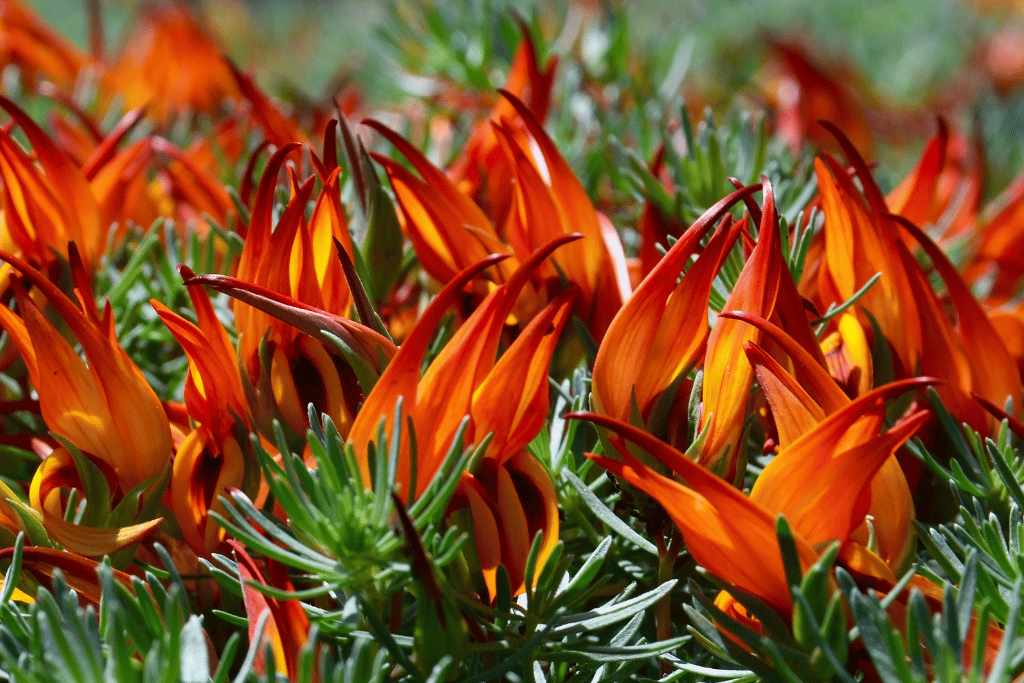
Representing individuality and innovation, the Parrot’s Beak plant introduces an element of the extraordinary to gardens. Its lively blossoms and intricate structure serve as a reminder of the limitless diversity present in the world of nature. Beloved for its distinct appearance and trailing growth habit, Parrot’s Beak is often used in containers, hanging baskets, and as a colorful accent in landscapes.
This particular plant flourishes when planted in soil with good drainage and placed in sunny spots. Its capacity to drape gracefully over the rims of pots or stone walls contributes to its visual allure. Belonging to the Fabaceae family, this perennial flora originates from the Canary Islands and displays elaborate orange or red blooms resembling the beak of a parrot. Scientifically referred to as Lotus berthelotii, the Parrot’s Beak introduces an exotic and intricate element to gardens through its distinctive and captivating flowers.
29. Painted Daisy – Vibrant Petal Palettes

The Painted Daisy introduces a burst of liveliness to gardens, flourishing under abundant sunlight and in soil that drains well. Its capacity to enhance outdoor spaces with its happy blooms is a memory of the delight nature’s handiwork can provide. Botanically known as Tanacetum coccineum, it brings vibrant petal palettes to gardens and landscapes. This perennial flowering plant, part of the Asteraceae family, originates from Europe and showcases daisy-like blooms in red, pink, and white shades.
Admired for its skill in drawing pollinators such as bees and butterflies, the Painted Daisy contributes beauty and ecological importance to outdoor areas. Serving as a representation of simplicity and beauty, the Painted Daisy is a favored selection for cottage gardens, borders, and wildflower meadows. The vibrant and joyful blossoms it produces evoke a feeling of innate allure.
30. Pink Oxalis – Delicate Leafy Charms

Pink Oxalis symbolizes luck and happiness, making it a meaningful choice for outdoor spaces. Its delicate leaves and charming flowers evoke a sense of playfulness and natural beauty. Pink Oxalis, scientifically known as Oxalis debilis, adds delicate leafy charms to gardens and containers. This perennial plant, part of the Oxalidaceae family, showcases shamrock-like leaves and dainty pink flowers, creating a whimsical and enchanting display.
Beloved for its unique foliage and low-growing habit, Pink Oxalis is often used in rock gardens, borders, and as a ground cover in landscapes. Thriving in partial shade to full sunlight, Pink Oxalis serves as a reminder of the surprises that can be found in the tiniest details of nature. Its petite presence adds a touch of elegance to gardens and landscapes.


